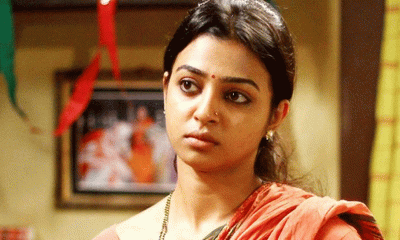Top News
‘Parched’ is much more than a film
 Film: “Parched”; Writer-Director: Leena Yadav; Cast: Tannishtha Chatterjee, Radhika Apte, Surveen Chawla, Lehar Khan, Adil Hussain; Rating: ****1/2
Film: “Parched”; Writer-Director: Leena Yadav; Cast: Tannishtha Chatterjee, Radhika Apte, Surveen Chawla, Lehar Khan, Adil Hussain; Rating: ****1/2
Long after “Parched” played out its poignant plot, I kept thinking about the four women at the forefront of Leena Yadav’s sparkling saga of patriarchal tyranny. The enduring grief and the brief bouts of buoyancy that Rani (Tannishtha Chatterjee), Lajjo (Radhika Apte), Bijlee (Surveen Chawla) and Janaki (Lehar Khan) carry with themselves, lingers in our hearts and minds long after the last frame of this luminous work dies down.
The film is shot with such inescapable beauty by Russell Carpenter (who moves with fluent fecundity from the soggy sappiness of “Titanic” to the parched desertscape of this walloping work on women’s empowerment), that you fear for the inner lives of the characters. Would their emotional existence be able to withstand the sheer extraneous splendor of the storytelling?
The answer, my friend, is blowing passionately in the winds. The winds of change, if you will. “Parched” is shot on location in the hearts of a glorious gallery of women who seem to have emerged from generations of oppression and longing into a tremulous, dim yet restorative and nourishing light to claim a place in the blue open skies.
“Parched” is a melancholic yet sunny meditation on feudal mindsets where women are treated as objects of recreation and contempt, to be used and discarded world. It’s a brutal life for the childless Lajjo who gets thrashed by her sodden husband regularly, for Bijlee the ‘nautanki’ sex worker who satisfies masculine lustful urges at the drop of a ghagra, Rani a mother at 14 a widow at 17 and now a discarded hag at 35-plus, and tender little child-bride Janaki who is yanked from her parental home and raped by her randy drunken teenage husband (Riddhi Sen, outstandingly loutish) who visits prostitutes, discusses his wife’s breasts with his friends and brags, “I am fulfilling my husbandly duties even when I don’t like my wife.”
Significantly, the writer-director creates two parallel universes for her women heroes. They are crestfallen shriveled dying flowers in their stifling domain of domesticity, but they blossom like summer flowers once together on joyrides in the outdoors, navigated into surreptitious excursions into ecstasy by the feisty Bijlee.
The bustling cosmos that “Parched” creates, comes dangerously close to over-reaching itself. Leena Yadav exercises enormous control and a profound empathy over the narrative. In this endeavour, she is vastly aided by editor Kevin Tent who displays remarkable ruthlessness over the cluttered material, leaving room for not a single superfluous moment.
“Parched” mirrors harsh home truths and dares to delve into areas of rural oppression and gender brutality that are normally not seen to be “relevant”, or seen to be too relevant to matter.
In a sense, “Parched” mirrors the other side of the truth about sexism and the single girl from what we saw last week in “Pink”. The women in this film are not sophisticated or urbane enough to fully fathom, let alone deal with their horrendous plight. Their sexual oppression goes hand in hand with their sexual innocence.
The way these women discuss their bodies and the sex act, or reach out for tenderness to countermand male brutality (I am sure they don’t know the word ‘lesbian’) has never been seen in any Indian film, at least not the ones I’ve seen.
There is also a curious reversal of societal ground-rules where women are often seen to be the worst enemies of their own gender. In “Parched”, all the women share a terrific kinship including Tannishtha’s character with her bed-ridden dying mother-in-law.
Moving and counter-enforcing gender stereotypes, there is a stirring stimulating energetic and erotic energy flowing out of “Parched”, as though the storyteller decides to pull out all stops to let her women characters speak their minds and act out their innermost fantasies, including one of the female heroes strange visit to a ‘Mystic Baba’ (Adil Hussain, suitably magnetic) who impregnates her. The sequence, a highpoint in the hoary history of female eroticism in Hindi cinema, is shot with a spiritual grace.
Curiously, the film’s physical look reminded me of Kalpana Lajmi’s “Rudali”, while its spiritual personality echoes Shyam Benegal’s “Ankur”, especially the preamble where Sayani Gupta in a heartrending cameo, is forced by her parents to return to her sadistic ‘sasural’.
A lot of the movie’s tradition-scoffing narrative works because of her actors. The ever-dependable Tannishtha and Radhika are magnificent. Their empathetic erotic sisterhood is heartbreaking in its desperation. Radhika’s comfort level with her physicality is stunningly refreshing for an Indian actress. When was the last time you saw an Indian actress slip out of her blouse facing the camera?
But the real surprise and the firecracker performer is Surveen Chawla. She furnishes her character of the devil-may-care prostitute with a quality of sublime seductiveness and unbridled sassiness.
I am not too happy with the way some of the male characters are painted in red, hastily relegated to a brutal zone just to play up the heroines’ stunning sisterhood, which per se, is enchanting.
“Parched” celebrates the joie de vivre of shared grief among women who live their wretched lives on the edge and are only too happily to topple over when pushed and provoked. Sometimes, feminism doesn’t need a full-blown messianic clarion call. A little tug, a firm push, will do. “Parched” hits us where it hurts the most.
And I don’t mean below the waist.
Entertainment
Casino Days Reveal Internal Data on Most Popular Smartphones

International online casino Casino Days has published a report sharing their internal data on what types and brands of devices are used to play on the platform by users from the South Asian region.
Such aggregate data analyses allow the operator to optimise their website for the brands and models of devices people are actually using.
The insights gained through the research also help Casino Days tailor their services based on the better understanding of their clients and their needs.
Desktops and Tablets Lose the Battle vs Mobile
The primary data samples analysed by Casino Days reveal that mobile connections dominate the market in South Asia and are responsible for a whopping 96.6% of gaming sessions, while computers and tablets have negligible shares of 2.9% and 0.5% respectively.
The authors of the study point out that historically, playing online casino was exclusively done on computers, and attribute thе major shift to mobile that has unfolded over time to the wide spread of cheaper smartphones and mobile data plans in South Asia.
“Some of the reasons behind this massive difference in device type are affordability, technical advantages, as well as cheaper and more obtainable internet plans for mobiles than those for computers,” the researchers comment.
Xiaomi and Vivo Outperform Samsung, Apple Way Down in Rankings
Chinese brands Xiaomi and Vivo were used by 21.9% and 20.79% of Casino Days players from South Asia respectively, and together with the positioned in third place with a 18.1% share South Korean brand Samsung dominate the market among real money gamers in the region.
Cupertino, California-based Apple is way down in seventh with a user share of just 2.29%, overshadowed by Chinese brands Realme (11.43%), OPPO (11.23%), and OnePlus (4.07%).
Huawei is at the very bottom of the chart with a tiny share just below the single percent mark, trailing behind mobile devices by Motorola, Google, and Infinix.
The data on actual phone usage provided by Casino Days, even though limited to the gaming parts of the population of South Asia, paints a different picture from global statistics on smartphone shipments by vendors.
Apple and Samsung have been sharing the worldwide lead for over a decade, while current regional leader Xiaomi secured their third position globally just a couple of years ago.
Striking Android Dominance among South Asian Real Money Gaming Communities
The shifted market share patterns of the world’s top smartphone brands in South Asia observed by the Casino Days research paper reveal a striking dominance of Android devices at the expense of iOS-powered phones.
On the global level, Android enjoys a comfortable lead with a sizable 68.79% share which grows to nearly 79% when we look at the whole continent of Asia. The data on South Asian real money gaming communities suggests that Android’s dominance grows even higher and is north of the 90% mark.
Among the major factors behind these figures, the authors of the study point to the relative affordability of and greater availability of Android devices in the region, especially when manufactured locally in countries like India and Vietnam.
“And, with influencers and tech reviews putting emphasis on Android devices, the choice of mobile phone brand and OS becomes easy; Android has a much wider range of products and caters to the Asian online casino market in ways that Apple can’t due to technical limitations,” the researchers add.
The far better integration achieved by Google Pay compared to its counterpart Apple Pay has also played a crucial role in shaping the existing smartphone market trends.
Content provided by Adverloom























